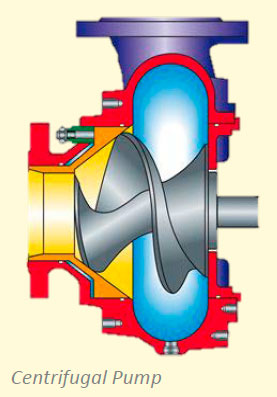Centrifugal Pumps:Centrifugal pump converts electrical energy into kinetic energy of the liquid by accelerating the latter using a revolving device -an impeller.
The fluid is accelerated in the outward direction radially from the pump chasing. The vacuum thus created at the impeller’s eye continuously draws more fluid into the pump.
STARTING
- Check if the pump rotates freely by hand, i.e. there are no obstructions in the pump or the drive motor
- Open any isolating valve and ensure that the pump is flooded, i.e. releasing of all air-locks in the pump or pipework
- Start the pump briefly to check for correct direction of rotation
- On start-up, it is advisable to partially close a valve in the pump discharge line to limit the initial flow surge
- Monitor the power taken by the drive motor
- Once running, the discharge valve should be progressively opened until the required flow rate and pressure is obtained, ensuring that the power taken is within the maximum rating of the drive motor
- The absorbed power is dependent on the pump performance and the properties of the fluid being pumped, i.e. specific gravity, viscosity and entrained solids etc.
- Remember that most centrifugal pumps must not be run 'dry' of process liquid because of the probable damage to the shaft seal or bearings on a magnetic drive unit

STOPPING
- Stop the power switch for the pump motor
- As the pump stops completely, shut off the suction and discharge valves
“Some pumps have screw-on impellers which may be loosened if the pump is running in the reverse direction.”
Piston Pump: Piston pumps are reciprocating type pumps wherein a piston moves inside a cylinder which creates suction and discharge effects for the liquid involved.
They are popularly used in bilge transfer system where suction capacity is quite efficient.
STARTING
- Open suction and discharge valves for the pump
- Open all other valves in the line going to pump’s suction and discharge
- Switch ON the breaker of the pump
- Switch ON the motor and start the pump
- When the pump begins to discharge, open the test valve on the top of the pump to remove air
- Check pump’s pressure, temperature and vibration
STOPPING
- Stop the motor switch and the pump will stop
- Shut suction and discharge valves of the pump
- Shut other line valves if they are not required
“Never throttle suction valve during the operation otherwise it may cause due to dry operation.”
Gear and Screw Pump: In gear and screw pumps, the liquid is trapped by the openings between the gear teeth/ screw of two identical gears/ screws and the chasing of the pump on the suction side.
STARTING
- Open all valves in the discharge line completely and de-energize the pressure relief valve (start-up pump without any backpressure)
- Ensure sufficient liquid level in the tank
- Turn on the motor
- Check the suction and pressure pipes for any leakage; avoid admission of air into the pump system
- Monitor the pressure and temperature monitoring devices frequently
- Check direction of rotation as incorrect direction of rotation will result in pump damage (dry running)
STOPPING
- Switch off the motor
- As the pump stops rotating, shut the suction and discharge valves
“A suction filter must be installed in the gear or screw pump as they have very fine clearance between the mating surfaces, which pumps the liquid. In absence of a filter, the surfaces may get damaged by foreign particles.”
Lobe Pump: Lobe pump is a positive displacement type pump with generally two lobes –the one driving or pumping the liquidis connected to the driving shaft and the other is connected to the driven shaft via helical gear. Both lobes rotate in synchronized manner without one touching the other.
STARTING
- Check suction and discharge valves of the pump
- Switch on the power supply to the motor
- As the pump rotates-check noise level and pressure
- Check and adjust the discharge pressure as required
STOPPING
- Switch off the power supply to the pump motor
- Shut the suction and discharge valves when the pump stops to avoid running the pump in opposite direction
Engineers working in the ship’s engine room are often found neglecting correct procedures while handling engine room machinery.
Many engineers skip steps, which they think are not-so-essential for starting or stopping a system.
Though a few steps might not directly affect the working of the machinery, they can be extremely harmful in the long run and even lead to unprecedented breakdown of equipment or internal parts.
Following a systematic procedure would not only ensure smooth running of engine room machinery but also reduce maintenance work to a great extent.
References
The Ultimate Guide to Operating Procedures of Engine Room Machinery. Anish Wankhede [2014]

